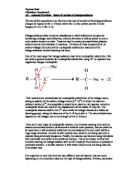It is important to note that there are two different sorts of reaction that can occur depending on the conditions used and the type of halogenoalkane. Primary, secondary and tertiary halogenoalkanes behave differently in this respect. These two reactions are substitution and elimination. In all cases, a mixture of both reactions will happen, some substitution and some elimination. However a number of factors determine the proportion of each. The most important factor is the type of halogenoalkane used, primary halogenoalkanes result in a mainly substitution reaction while secondary halogenoalkanes result in a mix and tertiary halogenoalkanes result in a mainly elimination reaction. Due to my investigation requiring a substitution reaction to take place, I will need to use a primary halogenoalkane. Other less important factors include the solvent, temperature and concentration of the sodium or potassium hydroxide solution however I will be ignoring these as they carry less of an influence.
As I will be using hydrolysis, the reaction is shown in the following equation:
CnHn+X + OH¯ CnHn+OH + X¯
This reaction can take place at room temperature. Halogenoalkanes do not mix with water, so ethanol is used as a solvent in which the Halogenoalkane and the aqueous sodium or potassium hydroxide both mix.
There is no colour change but the presence of a specific halide ion, X-, can be detected by testing with aqueous silver nitrate mixed with ethanol. Halogenoalkanes are covalently bonded, so they give no precipitate with silver ions but as the reaction proceeds and halide ions are produced, a percipitate of silver halide gradually forms – white for chloride ions, cream for bromide ions and pale yellow for iodide ions. Halogenoalkanes are insoluble in water, so the reaction is carried out in the presence of ethanol, which acts as a mutual solvent for the halogenoalkanes, the water and the silver ions but will not interfere with the reaction in any way.This reaction can be used to compare the rates at which the halogenoalkanes react, by mixing the silver nitrate solution with the reaction mixture and timing how long it takes for a percipitate to form.
Each halogenoalkane has a different bond strength, bond polarity and varying electronegativities.
As can be seen from the table above, the halogens decrease in electronegativity from Chlorine to Iodine, this forms a less polar molecule and therefore a smaller + charge on Carbon. However, the CarbonHalogen bond length increases from Chlorine to Iodine and the bond becomes weaker and is consequently more easily broken which accounts for the lower enthalpy. This means polarity and bond enthalpy give contradicting predictions on the rates of reaction.
My prediction for which bond will react most vigorously with the nucleophile at the greatest rate is C−I. For the reason that it has the lowest bond enthalpy meaning it can be broken with ease as it requires less energy. Consequently C−Br will not be as easy to break as C−I because of its higher bond enthalpy and will react slower. C−Cl will therefore be the hardest bond to break because it has the highest bond enthalpy of all the bonds being tested and will react slowest. I have decided to go with bond enthalpy as I feel that it is the more important property. I have dismissed polarity even though that would tell us that C−Cl would react quickest due to the large difference of sizes between the carbon and iodine resulting in a bigger Cδ+ charge thus allowing the nucleophile to attack the bond much easier.
For this experiment the following apparatus are needed:
- 3 test tubes
- Test tube rack
- Stopwatch
-
10 cm3 measuring cylinder
-
250 cm3 beaker
- Labels
- Bunsen burner
- Tripod
- Heat proof mat
- Thermometer
- Gauze
- Ethanol
-
Silver nitrate solution, AgNO3
- Water
- 1-chlorobutane
- 1-bromobutane
- 1-iodobutane
- Sodium Hydroxide
- Arrange three test tubes, into a test tube rack, in a row.
- Label them as ‘Chloro’, ‘Bromo’ and ‘iodo’ individually.
-
Using the 10.00 cm3 measuring cylinder, add 2.00 cm3 of the respective Halogenalkanes in the following sequence. (The reason for using a 10 cm3 measuring cylinder is that this is the most accurate way to measure out exact quantities of the halogenoalkanes)
-
Using a 10.00 cm3 measuring cylinder, measure out 2.00 cm3 of ethanol and add to each test tube (as previously stated, this acts as a solvent).
-
Measure out another 4.00 cm3 of the Silver nitrate, AgNO3, and pour into each test tube. (The silver nitrate is added to the halogenoalkanes because when the two are added together the halide ions that are produced form a silver halide precipitate. The precipitate tells us about the rate of hydrolysis in halogenoalkanes).
-
Take one of the test tube containing the halogenoalkane, ethanol and silver nitrate and as quickly as possible add 2.00 cm3 of Sodium Hydroxide and time with the stopwatch provided and stop when the colour change of the precipitate is formed. Note down the time taken and the colour of the solution.
- Repeat the steps using the other two test tubes and note the colour change of the precipitate formed and the time taken. (The colour change is important in distinguishing the exact halide that is produced, which should be evident from the specific halogenoalkanes used and the time taken is recorded as it is a representation of the rate of reaction which is what we need to compare).
- Results should be shown in a similar table as to below.
- Results should also be gained from at least 3 trials and an average be taken from them to ensure that any errors are given less weight to the end result.
The above method that has been planned out should work due to it following all the background analysis done previous to it. It contains all the right objects to achieve a successful nucleophilic substitution reaction.
As can be seen, my only variable throughout the exams is the different halogenoalkanes used. To ensure a fair test the following will need to be kept at a constant for all trials:
- The volume and concentration of the halogenoalkanes.
- The volume and concentration of ethanol
- The volume and concentration of silver nitrate solution
- The temperature of the water bath
Contamination of solutions will also need to be prevented by washing out any cylinders and equipment before reusing them.
Safety is exceptionally important and it is essential to follow safety procedures. It is important to wear eye protection when working with any chemicals that are irritant. Also long hair should be tied back. The halogenoalkanes are harmful when inhaled so every effort should be made not to breathe them in. Also as the chemicals used are highly flammable (1-iodobutane is flammable) it is important to take special care while working with and around them especially when near naked flame. Stoppers should be replaced straight away after use and kept well away from naked flames. Also to cuts and broken skin should be covered, and hands should be washed after handling the chemicals. If contact with skin does occur it should be washed with cold water immediately. The equipment needed to ensure safety would be goggles, lab coat, gloves and long hair tied back. Alcohol’s are corrosive and can cause irritation to the skin.
Refrences
Essential AS Chemistry for OCR – Ted Lister, Janet Renshaw – P 115-118
Word Count: 1680







